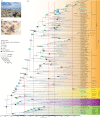300 Million years of coral treaders (Insecta: Heteroptera: Hermatobatidae) back to the ocean in the phylogenetic context of Arthropoda
- PMID: 37357866
- PMCID: PMC10291715
- DOI: 10.1098/rspb.2023.0855
300 Million years of coral treaders (Insecta: Heteroptera: Hermatobatidae) back to the ocean in the phylogenetic context of Arthropoda
Abstract
Among hundreds of insect families, Hermatobatidae (commonly known as coral treaders) is one of the most unique. They are small, wingless predaceous bugs in the suborder Heteroptera. Adults are almost black in colour, measuring about 5 mm in body length and 3 mm in width. Thirteen species are known from tropical coral reefs or rocky shores, but their origin and evolutionary adaptation to their unusual marine habitat were unexplored. We report here the genome and metagenome of Hermatobates lingyangjiaoensis, hitherto known only from its type locality in the South China Sea. We further reconstructed the evolutionary history and origin of these marine bugs in the broader context of Arthropoda. The dated phylogeny indicates that Hexapoda diverged from their marine sister groups approximately 498 Ma and that Hermatobatidae originated 192 Ma, indicating that they returned to an oceanic life some 300 Myr after their ancestors became terrestrial. Their origin is consistent with the recovery of tropical reef ecosystems after the end-Triassic mass extinction, which might have provided new and open niches for them to occupy and thrive. Our analyses also revealed that both the genome changes and the symbiotic bacteria might have contributed to adaptations necessary for life in the sea.
Keywords: arthropod phylogeny; genome; metagenome; origin of marine insects; phylogenomics; symbiotic bacteria.
Conflict of interest statement
The authors have no competing interests to declare.
Figures



Similar articles
-
Hydroids (Cnidaria, Hydrozoa) from Mauritanian Coral Mounds.Zootaxa. 2020 Nov 16;4878(3):zootaxa.4878.3.2. doi: 10.11646/zootaxa.4878.3.2. Zootaxa. 2020. PMID: 33311142
-
First record of Hermatobatidae from China, with description of Hermatobates lingyangjiaoensis sp. n. (Hemiptera: Heteroptera).Zootaxa. 2019 Oct 3;4679(3):zootaxa.4679.3.6. doi: 10.11646/zootaxa.4679.3.6. Zootaxa. 2019. PMID: 31715949
-
The evolution of fishes and corals on reefs: form, function and interdependence.Biol Rev Camb Philos Soc. 2017 May;92(2):878-901. doi: 10.1111/brv.12259. Epub 2016 Mar 11. Biol Rev Camb Philos Soc. 2017. PMID: 26970292
-
Impacts of marine debris on coral reef ecosystem: A review for conservation and ecological monitoring of the coral reef ecosystem.Mar Pollut Bull. 2023 Apr;189:114755. doi: 10.1016/j.marpolbul.2023.114755. Epub 2023 Mar 10. Mar Pollut Bull. 2023. PMID: 36905864 Review.
-
Phylogenetic perspectives on reef fish functional traits.Biol Rev Camb Philos Soc. 2018 Feb;93(1):131-151. doi: 10.1111/brv.12336. Epub 2017 May 2. Biol Rev Camb Philos Soc. 2018. PMID: 28464469 Review.
Cited by
-
An initial comparative study on the antennal morphology of Zoraptera (Insecta) with special reference to the sensilla.Sci Rep. 2025 Jul 5;15(1):24057. doi: 10.1038/s41598-025-08212-x. Sci Rep. 2025. PMID: 40617946 Free PMC article.
-
Comparative cytogenetics of three Zoraptera species as a basis for understanding chromosomal evolution in Polyneoptera insects.PeerJ. 2024 Oct 10;12:e18051. doi: 10.7717/peerj.18051. eCollection 2024. PeerJ. 2024. PMID: 39399435 Free PMC article.
-
Diversity pattern of insects from Macao based on an updated species checklist after 25 years.Biodivers Data J. 2024 Apr 5;12:e118110. doi: 10.3897/BDJ.12.e118110. eCollection 2024. Biodivers Data J. 2024. PMID: 38617834 Free PMC article.
References
-
- Cheng L. 1977. The elusive sea bug Hermatobates. Pan-Pacific Entomol. 53, 87-97.
-
- Carpenter GH. 1892. Rhynchota from Murray Island and Mabuiag. Reports on the Zoological collections made in Torres Straits by Professor Haddon AC, 1888–1889. Sci. Proc. R. Dublin Soc. 7, 137-146.
-
- Andersen NM, Weir TA. 2000. The coral treaders, Hermatobates Carpenter (Hemiptera: Hermatobatidae), of Australia and New Caledonia with notes on biology and ecology. Invertebr. Taxon. 14, 327-345. (10.1071/IT99012) - DOI
-
- Polhemus JT, Polhemus DA. 2012. A review of the genus Hermatobates (Heteroptera: Hermatobatidae), with descriptions of two new species. Entomol. Am. 118, 202-241. (10.1664/12-RA-018.1) - DOI
Publication types
MeSH terms
Associated data
LinkOut - more resources
Full Text Sources

